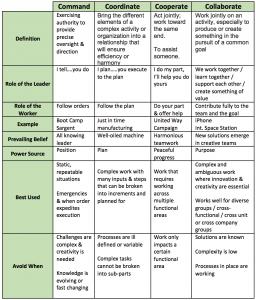True confession….when no less than three different clients this year asked for help on collaboration I experienced a sense of validation and vindication. On no less than three prior occasions, as I was up for a promotion in my earlier careers, I was denied. The reason for not making the cut: “I was TOO collaborative.”
There was no denying I was collaborative. Still am. Always will be. I do my best work side by side with others, dreaming, creating, and then doing. But TOO collaborative? How could that be?
Because of my ability to collaborate, the solutions that emerged to solve business problems were innovative. They stuck. They had deep support from key influencers. Wasn’t that a good thing?
And so, in the past few months I’ve done something else I’m really good at – exploring the concept of collaboration. Reading the current thought leaders (with no less than 6 books consumed). Defining it. Creating content. Facilitating workshops.
Through all this work, I came to a stunning conclusion. It’s an insight that was years in the making, but before I share that, let me share some thoughts on why collaboration such a “hot topic”.
Some Background
At the turn of the 20th century, when new inventions such as telegraphs and telephones and faster forms of transportation enabled the better movement of goods and people, larger and more centralized organizations took shape. It was a time of centralization and with that specialization. It was a time when bigger was better, and it was a time where industry disruption was measured in decades and not days. Where the more efficient you could be, the better the results you realized.
Today we are in the midst of a dramatic and foundational shift. This is due to a myriad of factors: lightning speed communication to anyone just about anywhere, affordable computing power, global connectivity and the emergences of breakthrough ideas faster than they are able to be consumed.
The Implications
Due to that shift, entire industries are disrupted regularly, often from an unforeseen competitor. Who could have imagined that the taxi companies that had big cities locked down would face fierce competition from someone from the suburbs with a Honda Civic, a smart phone and some time on their hands? Who would have thought that anyone could carry a library full of books on a device that fits in their hand twelve years ago? Do you suspect that the execs at Hilton and Hyatt were planning to be out performed by a scattered network of homeowners and an App? (Interesting note: today AIRBNB exceeds the valuation of Hilton and Hyatt combined in spite of having no “real” properties, only technology and a network of collaborators).
We are in a time when being large may be a liability, when no one leader can know it all, and when fresh ideas and quick time to market is a vital competitive advantage.
We are in a time where collaboration, not competition, is the advantage you need to remain relevant, to be sustainable, to thrive.
The Reality
Yet today many organizations and leaders are stuck in different paradigms: That bigger is better. That the leader is the one that knows all and directs all. That diverse people and ideas are window dressing rather than a true creative and competitive advantage. That leadership resides at the top and that allowing it to surface anywhere else in the organization presents a threat to maintaining order, position and efficiency.
Many are realizing that these “industrial era” beliefs are getting in the way, hindering performance and unsustainable. They realize there needs to be a new way to operate in a world that moves so quickly, that being nimble is more important than being big, and creativity and innovation are crushed in command and control environments. They realize that collaboration is the way forward.
So What Exactly is Collaboration?
That is exactly the question I’ve explored in the last three months. As I often find it helpful to define concepts by what they are not, the chart below both defines and contrasts collaboration to commanding, coordinating, and cooperation. Many are close cousins, but to me, collaboration is defined and differentiated by this:
Collaboration is when a diverse group of people work side by side to co-create a solution to a problem that none of them could have solved on their own. It is marked by a deep sense of trust and respect for all team members and a strong desire by all to achieve a common purpose that matters. It is when purpose is held in higher regard than position. It is messy at times. The exploratory nature of collaboration means it is neither very linear nor very efficient. It is a place of ideas, of experimentation, of possibilities. It is an environment in which individual egos are sublimated and where a sense of camaraderie and team work prevail. It is the fertile ground from which radically new ideas, products and solutions emerge.
My Stunning Conclusion
As I did this deeper dive into collaboration, it suddenly hit me: “they were right – I was too collaborative!” For I realized that, for me, collaboration was an overused strength. Collaboration, by its nature, is inefficient, both in time and resources. It is an amazing leadership style when situations are complex and solutions are unknown. But in many situations, in which decisions need to be made quickly or when the answer is knows – a collaborative approach is inefficient, frustrating for others and wastes precious time and resources. Knowing when to be a leader that fosters collaboration is great, but in my growth areas were to know when to collaborate and when to shift into a different leadership style, more attuned to the situation.
So, in the spirit of helping you become a better leader, here is my summary of “collaboration at a glance”. In subsequent posts, I’ll do deeper dives into collaboration, so a great starting point is understanding where collaboration fits in the range of leadership actions.
Collaboration at a Glance






2 Responses
great summary Kris!
SO well-written and compelling
Thanks, Kris!
Comments are closed.